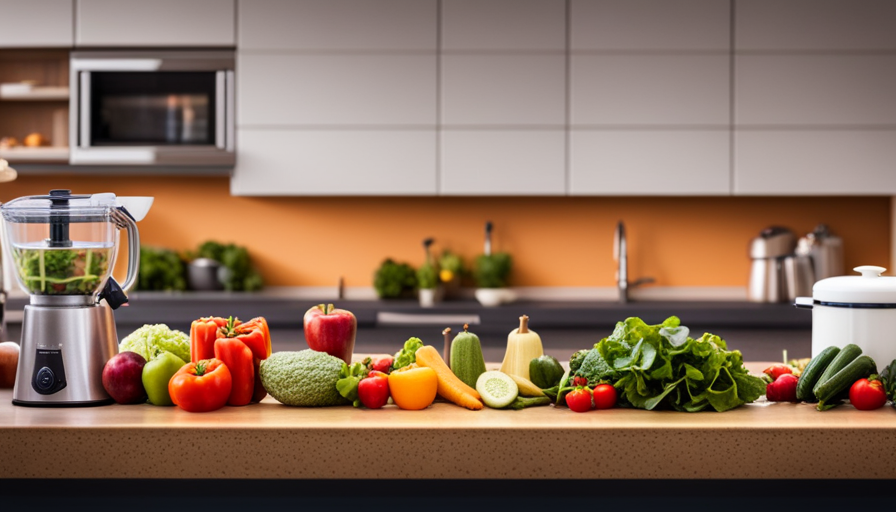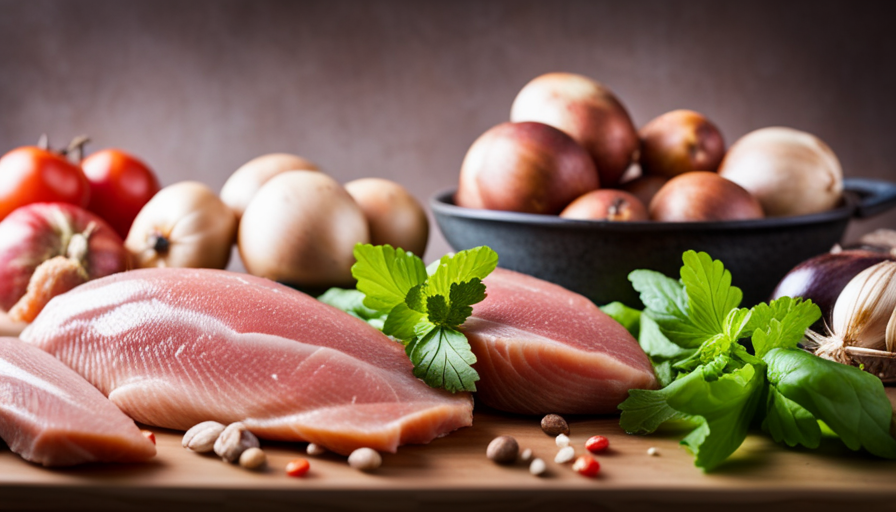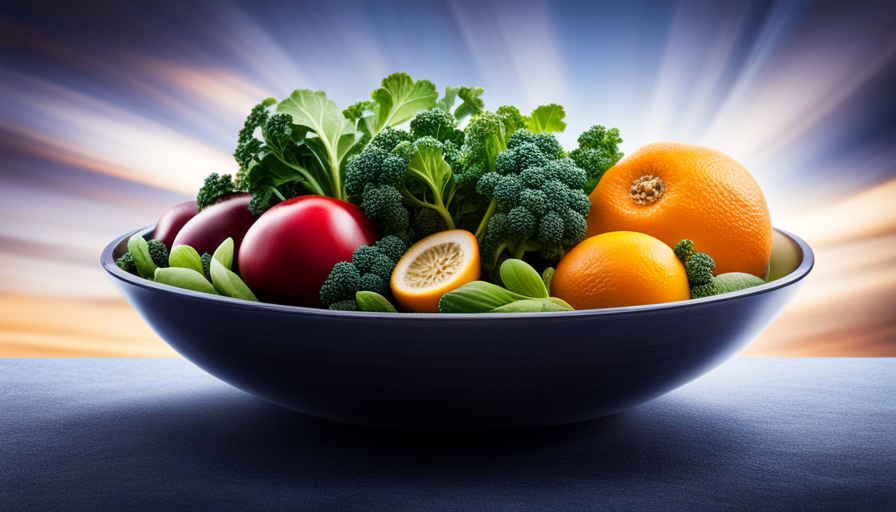Have you ever thought about the incredible benefits of incorporating raw foods into your diet? Look no further! This article serves as your guide to finding motivation and inspiration to include more raw foods in your meals.
By incorporating this nutrient-rich and vibrant way of eating into your daily routine, you can experience increased energy, improved digestion, and a strengthened immune system. With a focus on delicious raw food recipes, success stories, and practical tips, you’ll discover the keys to sustaining motivation for long-term raw food success.
We’ll even show you how to overcome common challenges and shop for raw food on a budget. So, get ready to embark on this transformative adventure and join the thriving community of raw food enthusiasts. It’s time to unleash your full potential and embrace the health benefits of a raw food lifestyle.
Key Takeaways
- Increased energy, improved digestion, and a strengthened immune system are some of the benefits of a raw food diet.
- Incorporating nutrient-rich raw fruits and vegetables into your meals can provide a wide range of health benefits.
- There are delicious and versatile options available for raw food, debunking the myth that it is boring or restrictive.
- Finding inspiration and motivation from raw food success stories can help you stay motivated to eat more raw food.
Understanding the Benefits of a Raw Food Diet
Imagine waking up every morning feeling refreshed and energized, knowing that by nourishing your body with raw fruits and vegetables, you’re reaping the countless benefits of a raw food diet.
Understanding the benefits of a raw food diet is essential in motivating yourself to incorporate more raw food into your daily meals. There are many misconceptions and myths surrounding raw food that can deter people from trying it, but once you debunk these myths, you’ll see why it’s worth giving raw food a chance.
One common misconception about raw food is that it lacks nutrients. However, this couldn’t be further from the truth. Raw fruits and vegetables are packed with essential vitamins, minerals, and enzymes that are often lost during cooking. By consuming them in their raw state, you’re maximizing their nutritional value, which can lead to increased energy levels, improved digestion, and a stronger immune system.
Another myth about raw food is that it’s tasteless and boring. On the contrary, raw food can be incredibly delicious and versatile. From colorful salads and refreshing smoothies to zucchini noodles and tasty raw desserts, there are endless possibilities to explore. Experimenting with different flavors and textures will keep your meals exciting and help you stay motivated to eat more raw food.
By understanding these raw food misconceptions and debunking the myths, you can unlock the full potential of a raw food diet. Not only will you experience improved health and vitality, but you’ll also discover a whole new world of flavors and culinary delights. So why not give raw food a try and see the amazing benefits it can bring to your life?
Exploring Delicious Raw Food Recipes
Try out these mouthwatering raw food recipes that’ll leave you craving for seconds, as studies show that incorporating just one raw meal a day can boost your energy levels by 20%!
Here are three delicious raw food recipes to satisfy your sweet tooth and snack cravings:
-
Raw Food Desserts:nnIndulge in guilt-free treats with raw food desserts. Try making raw chocolate avocado mousse by blending ripe avocados, raw cacao powder, and a natural sweetener like dates or maple syrup. This creamy and decadent dessert is rich in healthy fats and antioxidants.
-
Raw Food Snacks:nnFor a quick and nutritious snack, make raw energy balls. Combine dates, nuts, and your favorite superfoods like chia seeds or goji berries in a food processor. Roll the mixture into bite-sized balls and refrigerate for a convenient grab-and-go snack that’ll keep you energized throughout the day.
-
Raw Food Smoothies:nnBoost your raw food intake with refreshing smoothies. Blend together a mix of fresh fruits, leafy greens, and a liquid base like coconut water or almond milk. Customize your smoothie by adding superfood powders like spirulina or maca for an extra nutritional punch.
Incorporate these raw food desserts and snacks into your diet to not only satisfy your taste buds but also to reap the health benefits of a raw food lifestyle.
Incorporating Raw Food into Your Daily Routine
Transform your daily routine by infusing your meals with the vibrant, nutrient-rich goodness of raw food. Not only will you be nourishing your body with essential vitamins and minerals, but you’ll also be adding a burst of flavor and freshness to your meals.
Incorporating raw food into your daily routine doesn’t have to be complicated or time-consuming. In fact, there are plenty of quick and easy raw food snacks that you can enjoy on the go.
One simple idea is to make a raw fruit and nut trail mix. Simply mix together your favorite raw nuts, such as almonds or cashews, with dried fruits like goji berries or raisins. This snack is not only delicious, but it’s also packed with nutrients and provides a great energy boost during the day.
Another way to incorporate raw food into your daily routine is by adding raw vegetables to your family meals. You can start by including a side salad with every meal, filled with a variety of raw vegetables like lettuce, cucumber, and tomatoes. You can also try making raw veggie wraps using lettuce leaves as a substitute for tortillas.
By incorporating these quick and easy raw food snacks into your daily routine and finding creative ways to include raw vegetables in your family meals, you can easily increase your intake of raw food and enjoy the benefits of a healthier and more vibrant lifestyle.
Finding Inspiration in Raw Food Success Stories
Get inspired by real-life stories of people who’ve achieved incredible health and vitality by embracing the power of raw food. Finding motivation to eat more raw food can be challenging, but hearing about others’ success can provide the inspiration you need to make positive changes. Here are four reasons why reading raw food success stories can help you find motivation:
-
Proof of possibility: Reading about real people who’ve experienced amazing transformations through raw food shows you that it’s possible to achieve similar results. Their stories prove that raw food can lead to improved health and vitality.
-
Inspiration to overcome challenges: Raw food success stories often highlight the challenges and obstacles individuals faced on their journey. Seeing how they overcame these hurdles can inspire you to push through your own struggles and stay committed to your raw food goals.
-
New ideas and recipes: Raw food success stories often include details about the specific foods and recipes individuals incorporated into their diet. This provides you with new ideas and inspiration for delicious and nutritious raw meals.
-
Community support: Reading raw food success stories helps you feel connected to a larger community of individuals also seeking to improve their health through raw food. This sense of community provides support, motivation, and accountability as you work towards your own raw food goals.
By seeking inspiration in raw food success stories, you can find the motivation you need to incorporate more raw food into your daily routine and experience the incredible health benefits that come with it.
Overcoming Common Challenges in Transitioning to Raw Food
Don’t let common challenges deter you from embracing the power of raw food in your life and experiencing the incredible health benefits that come with it. While transitioning to a raw food diet may present some obstacles, there are effective ways to overcome them and stay motivated.
One common challenge is dealing with cravings. As you switch to a raw food lifestyle, your body may crave the comfort of cooked or processed foods. To overcome this, focus on incorporating a variety of flavors and textures into your raw meals. Experiment with different fruits, vegetables, nuts, and seeds to satisfy your taste buds and keep cravings at bay.
Another challenge is navigating social situations. Eating raw food may be different from what your friends or family are accustomed to, which can make social gatherings challenging. Communicate your dietary choices with your loved ones, and offer to bring a raw dish to share. This way, you can still enjoy the company of others while staying true to your health goals.
To further support you in your journey, here is a helpful table that outlines strategies for overcoming cravings and dealing with social situations:
| Overcoming Cravings | Dealing with Social Situations |
|---|---|
| Experiment with flavors | Communicate your choices |
| Try different textures | Bring a raw dish to share |
| Stay hydrated | Be confident in your decisions |
| Seek support | Educate others about raw food |
By implementing these strategies and staying motivated, you can successfully overcome common challenges and fully embrace the raw food lifestyle. Remember, the incredible health benefits are well worth it.
Creating a Raw Food Meal Plan
Transitioning to a raw food diet can be a challenge, but once you overcome the common obstacles, you’ll find yourself on a path to vibrant health. Now that you’re ready to take the next step, let’s talk about creating a raw food meal plan that will keep you motivated and satisfied.
Meal prep is key when it comes to sticking to a raw food diet. By dedicating some time each week to plan and prepare your meals, you’ll be setting yourself up for success. Start by stocking your pantry with a variety of raw fruits, vegetables, nuts, and seeds. These will serve as the building blocks for your meals.
Next, think about incorporating raw food snacks into your meal plan. Raw nuts, seeds, and dehydrated fruits make for great on-the-go options. You can also prepare raw energy balls or bars that you can grab whenever hunger strikes.
When creating your meal plan, aim for a balance of nutrients and flavors. Include a variety of colorful fruits and vegetables to ensure you’re getting a wide range of vitamins and minerals. Experiment with different combinations and seasonings to keep your taste buds excited.
Remember, transitioning to a raw food diet is a journey. Take it one step at a time and don’t be too hard on yourself. With a well-thought-out meal plan and some delicious raw food snacks, you’ll be well on your way to embracing a healthier and more vibrant lifestyle.
Shopping for Raw Food on a Budget
Shopping for raw food on a budget can be a challenge, but with a little creativity and planning, you can nourish your body while saving money. When it comes to meal prep, there are some tips you can follow to make the most of your budget.
First, buy in bulk. Purchasing larger quantities of raw ingredients can often be cheaper in the long run. You can portion them out and freeze them for later use.
Another tip is to plan your meals in advance. This way, you can make a shopping list and stick to it, avoiding impulse purchases that can add up.
One great way to find affordable raw food options is by visiting your local farmers market. Not only will you be supporting local farmers, but you can also find fresh, seasonal produce at a lower cost compared to supermarkets. Additionally, farmers markets often have a wider variety of organic and pesticide-free options, allowing you to prioritize your health while staying within your budget.
Shopping for raw food on a budget may require some extra effort, but it’s definitely possible. By implementing meal prep tips and exploring farmers market finds, you can eat more raw food without breaking the bank. So go ahead, get creative, and enjoy the benefits of a raw food diet while saving money.
Joining Raw Food Communities for Support and Encouragement
Embrace the sense of belonging and camaraderie by joining raw food communities, where you’ll find an abundance of support and encouragement, like a warm hug on a chilly day. Connecting with others who share your passion for raw food can be incredibly motivating and inspiring.
One of the best ways to get involved is by attending raw food community events. These events are a great opportunity to meet like-minded individuals, exchange recipes and tips, and learn from experienced raw food enthusiasts.
Virtual raw food support groups are another fantastic resource for finding support and encouragement. These online communities provide a platform for individuals to share their journey, ask questions, and receive advice from others who have been through similar experiences. You can join discussions, participate in challenges, and even find accountability partners to keep you motivated.
In addition to the emotional support, raw food communities often organize educational workshops and classes. These can be valuable resources for learning new techniques, discovering new recipes, and expanding your knowledge about the benefits of raw food.
By joining raw food communities, you’ll surround yourself with people who understand and appreciate your goals. You’ll feel inspired, motivated, and supported on your journey towards incorporating more raw food into your diet. So why not take that first step and reach out to these communities today?
Discovering the Health Benefits of Raw Food
Immerse yourself in the world of raw food and uncover the incredible health benefits that await you, igniting a newfound passion for vibrant living. Raw food isn’t just about eating fruits and vegetables in their natural state; it’s a lifestyle that embraces the power of nutrition and the impact it can have on your overall well-being.
By exploring the science behind raw food nutrition, you’ll discover that eating raw can provide you with an abundance of vitamins, minerals, and enzymes that are often lost during cooking. These nutrients can boost your immune system, improve digestion, and increase energy levels.
Here are some key health benefits of a raw food diet:
-
Enhanced nutrient absorption: Raw foods are easier for your body to digest, allowing for better absorption of essential nutrients.
-
Weight management: A diet rich in raw fruits and vegetables can help you maintain a healthy weight and reduce the risk of obesity-related diseases.
-
Increased energy levels: Raw food is packed with natural sugars and enzymes that can provide a sustained energy boost throughout the day.
-
Improved skin health: The abundance of vitamins and antioxidants in raw food can promote healthy skin and a youthful appearance.
-
Reduced environmental impact: By choosing raw food options, you’re supporting sustainable farming practices and reducing the carbon footprint associated with food processing and cooking.
By understanding the science behind raw food nutrition and exploring its environmental impact, you can make informed choices that will benefit both your health and the planet. So, take a leap into the world of raw food and experience the transformative power it can have on your overall well-being.
Sustaining Motivation for Long-Term Raw Food Success
To sustain your long-term success with a raw food lifestyle, envision yourself as a vibrant and energetic individual, effortlessly making choices that nourish your body and support your overall well-being. The key to sustaining motivation for long-term raw food success lies in finding sustainable motivation strategies that keep you inspired and on track.
One effective strategy is to set realistic goals and celebrate your achievements along the way. Break down your long-term goal into smaller, more manageable milestones and reward yourself when you reach them. This will help you stay motivated and excited about your progress.
Another way to sustain motivation is to surround yourself with like-minded individuals who share your passion for raw food. Joining a raw food community or finding a support group can provide you with the encouragement and accountability you need to stay on track.
Additionally, it’s important to stay informed about the health benefits of raw food. Educate yourself about the positive impact that raw food can have on your overall well-being, such as increased energy levels, improved digestion, and enhanced immune function. This knowledge will serve as a reminder of why you chose this lifestyle in the first place and help you stay motivated in the long run.
By implementing these sustainable motivation strategies, you can ensure long-term success with your raw food lifestyle and enjoy the numerous health benefits that come with it.
Frequently Asked Questions
Can I still eat cooked food while transitioning to a raw food diet?
Yes, you can still eat cooked food while transitioning to a raw food diet. Incorporating cooking techniques into your diet can help ease the transition and make it more sustainable. While raw foods offer numerous benefits such as increased nutrient content and digestive enzymes, cooked foods also have their advantages. Cooking can enhance the flavors, make certain nutrients more bioavailable, and help kill bacteria. Finding a balance between raw and cooked foods can provide you with a wide range of nutrients and flavors for a healthy and enjoyable diet.
How can I ensure I am getting all the necessary nutrients from a raw food diet?
To ensure you’re getting all the necessary nutrients from a raw food diet, focus on nutrient balance. Incorporate a variety of fruits, vegetables, nuts, and seeds to meet your body’s needs. Pay attention to protein sources like legumes and leafy greens. Additionally, consider supplementing with vitamin B12, as it’s commonly lacking in a raw food diet.
Remember, a well-balanced raw food diet can support weight loss while providing essential nutrients for optimal health.
Are there any specific kitchen tools or appliances I need to start a raw food diet?
To start a raw food diet, there are several kitchen tools that can make raw food preparation easier and more enjoyable. A high-speed blender is essential for creating smoothies, sauces, and dressings.
A food processor is great for chopping and slicing fruits and vegetables.
A spiralizer is useful for making raw pasta from zucchini or carrots.
Additionally, a dehydrator can be used to make delicious raw snacks like kale chips or fruit leather.
These tools will help you create a variety of delicious and nutritious raw meals.
How can I deal with cravings for unhealthy foods while on a raw food diet?
To deal with cravings for unhealthy foods while on a raw food diet, it’s important to have a plan in place.
Start by identifying the triggers that lead to these cravings, such as stress or boredom.
Then, find healthier alternatives to satisfy your cravings, like raw fruit or vegetables.
Stay motivated by reminding yourself of the benefits of a raw food diet, such as improved digestion and increased energy.
Remember, consistency is key, so stay committed to your goals and make healthy choices a habit.
Is it necessary to only eat organic foods when following a raw food diet?
Are you ready to take your raw food diet to the next level?
Incorporating organic foods into your routine can provide numerous benefits. Organic produce is grown without the use of harmful pesticides, chemicals, or genetically modified organisms (GMOs), making it a healthier choice.
Consuming non-organic raw foods may expose you to potential health risks, such as pesticide residue. By opting for organic options, you can ensure that you’re nourishing your body with the purest, most natural ingredients available.
How Can I Encourage Colonists to Transition to Eating More Cooked Food Instead of Raw Food?
To encourage colonists eating raw food to transition to cooked food, emphasize the benefits of cooked food such as improved digestion and nutrient absorption. Introduce new cooked recipes and highlight the delicious flavors and aromas. Educate colonists about the safety advantages of cooked food in preventing foodborne illnesses.
Conclusion
Congratulations on taking the first step towards a healthier lifestyle by exploring the world of raw food! By incorporating more raw food into your daily routine, you’re not only nourishing your body with essential nutrients but also reaping the countless health benefits that come with it.
With the help of delicious recipes, inspiring success stories, and support from raw food communities, you can overcome any challenges and sustain your motivation for long-term success. So, what are you waiting for? Dive into the world of raw food and let it be the key to unlocking a healthier, happier you.
Trust the process and watch as your body transforms into a vibrant masterpiece.










